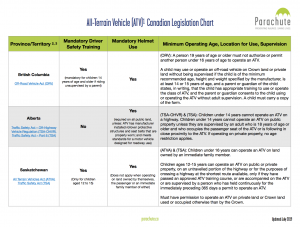Issue: ATV-related injuries
The rise in popularity of all-terrain vehicles (ATVs) is accompanied by a rise in catastrophic injury. Off-highway vehicles (OHVs), including ATVs and snowmobiles, pose significant risks, including death, to child drivers, passengers and pedestrians.
Problem: Child and youth riders
Like cars, ATVs are motorized vehicles that require adult skills and judgment to operate safely. ATVs can travel up to speeds of 105 km/h and weigh up to 227 kilograms (approximately 500 pounds).
Parachute recognizes that while ATVs and snowmobiles pose a degree of risk to all riders, the risks are greater for children and youth.
The Canadian Paediatric Society notes that children and youth are at special risk for OHV injuries and deaths as they lack the knowledge, physical development and cognitive and motor ability to safely drive these machines. Young children also do not have the strength to hold on for very long.
According to data from the Canadian Hospitals Injury Reporting and Prevention Program, serious injuries have occurred to children in recreational areas, on roads, highways and farms.
Solutions
Parachute supports injury prevention measures including legislating age-appropriate OHV usage, driver education and the proper use of protective equipment.
Legislating age-appropriate usage
Parachute joins a number of injury prevention organizations in calling for ATV regulations based on scientific evidence and reflecting the benefits of automobile legislative efforts. Parachute supports a minimum age of 12 to ride an ATV as a passenger, a minimum age of 14 to operate an ATV under the supervision of an adult who is within clear sight of the rider and a minimum age of 16 to operate an ATV without supervision and to carry a passenger who is younger than 18.
In the absence of legislation mandating age-appropriate use of ATVs and OHVs, Parachute does recognize the value of educating younger riders in rural and farming communities for the purpose of work and travel. This can be a great opportunity for parents to model safe behaviour and explain that, just like driving cars, ATVs need adult skills and knowledge.
In addition to minimum age requirements, Parachute supports legislation that requires the use of appropriately sized ATVs. Both operators and passengers should be able to simultaneously reach their foot pegs, grasp their handles and sit down fully in their seats. Operators should additionally be able to comfortably reach and operate all ATV controls. Parachute supports the following intended usage categories as defined by the American National Standards Institute – Standard for Four Wheel All-Terrain Vehicles:
- Category Y-12+ ATVs intended for use by children age 12 or older (under adult supervision) with a maximum speed capacity range of 24 km/h to 48 km/h and
- Category T (Transition Model) ATVs intended for use by an operator age 14 or older (under adult supervision) with a maximum speed capacity range of 32 km/h to 61 km/h.
Driver education
Parachute also recommends legislation that requires the completion of age-appropriate safety training by all ATV riders. This training should include both knowledge-based and skill-based (practical) components. Appropriate training classes are a great way to develop the skills, knowledge and confidence required to safely ride an ATV.
While Parachute is highly supportive of ATV and OHV safety training, we do not have enough evaluation research at our disposal to recommend a particular training approach.
Protective equipment
As hospital data indicate that head injuries are a serious risk of ATV and OHV incidents, Parachute advocates for the use of appropriate helmets, gloves, eye protection, footwear and clothing during ATV and OHV use for riders of all ages.
